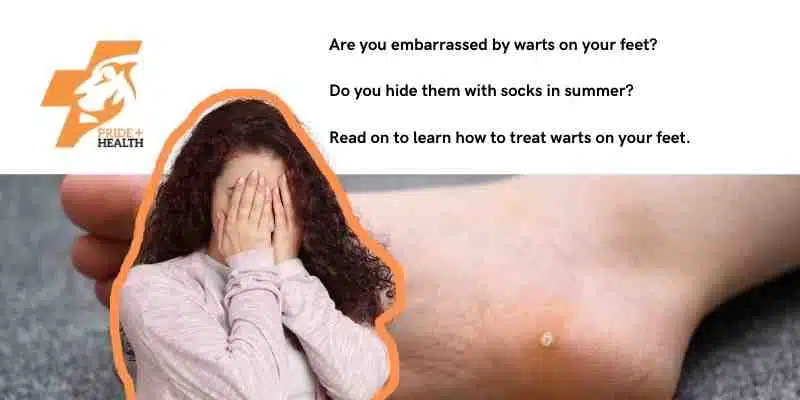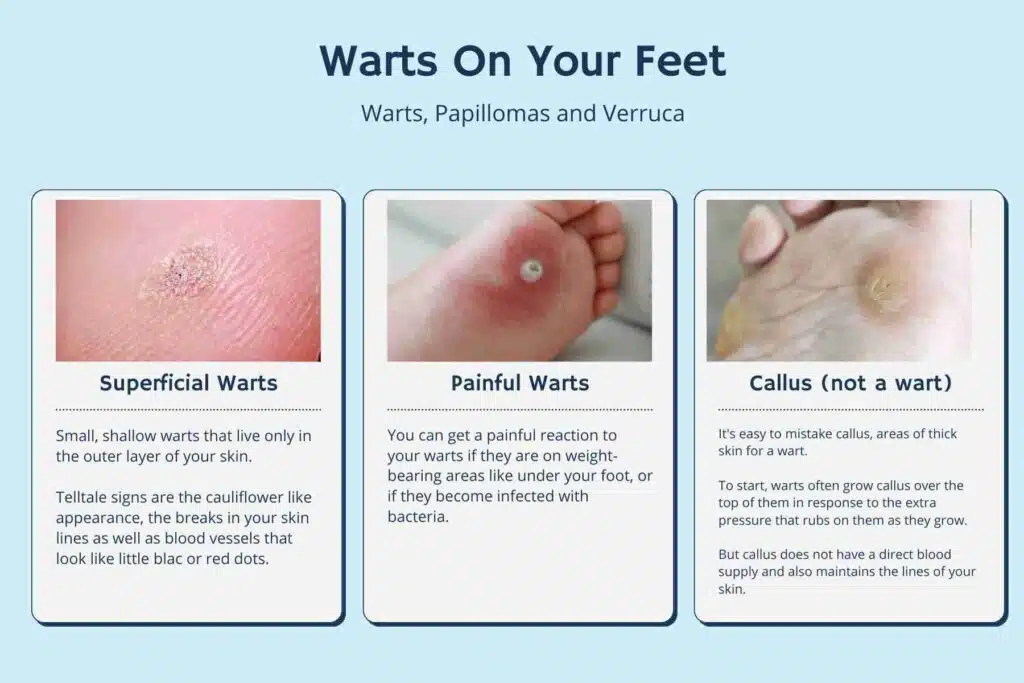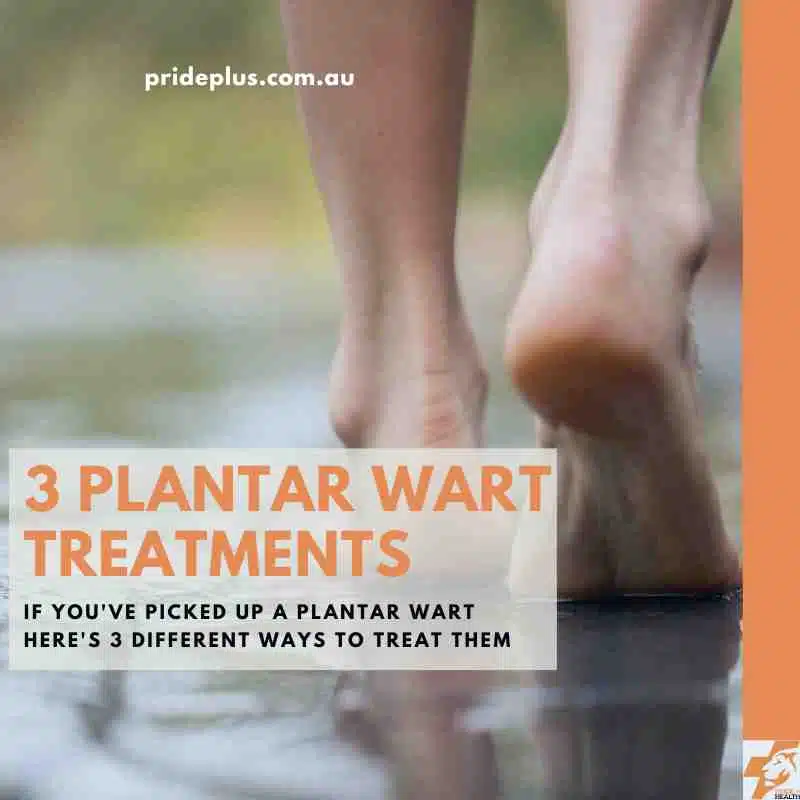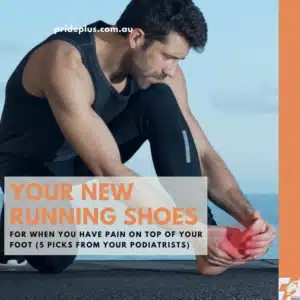By the time you’ve finished reading this article, you’re going to know everything you need to treat your plantar wart.
And I mean need to know.
If you’re reading this then you already know how embarrassing having a wart on your feet is. You know the feeling of having to keep your shoes and socks on to cover up the unsightly growth that is a plantar wart. You might also be sick of wearing thongs in the shower to protect your loved ones from catching your plantar wart too.

Unfortunately, though, not everyone can follow through with their plantar wart treatment to get the ultimate success. Plantar wart-free feet.
Plantar wart treatment takes time.
There’s no immediate fix for a common wart. But before you say stuff it – and keep searching for that miracle cure, stick with me for 2 more sentences.
I know this, as I’ve suffered with a plantar wart myself and as a podiatrist with over 12 years of experience I threw everything at it. I’m proud to say that getting rid of my plantar wart was worth the effort now I can walk around in summertime with my feet out again.
The few weeks I had to stick at the treatment were well and truly worth it.
Here are the reasons why people fail to treat their plantar warts.
- It’s not a plantar wart, it’s a plantar corn.
- They think that if they pull out the “root” it will be gone.
- Apply an over-the-counter remedy for 3 days only and then give up.
- They see their doctor for their common wart to be frozen off, only to develop a painful scar tissue that continues to return thicker and more painful every week.
Now that you know why people fail – you’re already halfway there to having the ultimate success in treating your plantar wart. You’re not going to make those mistakes. You’re ready.
Here’s how to treat your common wart.
Option 1: Treat your plantar wart at home.
If you can reach your plantar wart then you can treat it at home with a safe and effective topical treatment.
And it’s not wart pads or lotions from the chemist that you’re going to use. You’ll use a topical retinoid, a high-dose Vitamin A serum that disrupts the wart from building new wart tissue.
If you think that treating your plantar wart at home is for you, follow this guide on how to treat warts on your feet.
Option 2: See your foot doctor.
Plantar warts are one of the more common presentations that come into our podiatry clinics so we’ve plenty of experience and options to help. In particular, a core skill of podiatrists is understanding foot function and pressure care.
Your podiatrist will be able to design appropriate offloading to ensure that while you’re treating your plantar wart you won’t be suffering from pain with any extra pressure on the lesion.
The actual treatment that podiatrists use to win the war against plantar warts varies. A combination of surgical debridement, medicaments like salicylic acid or silver nitrate as well as topical retinoids are often used.
Depending on the location of your plantar wart, your immune system and a whole host of personal factors you and your podiatrist will be able to develop a specific treatment plan to get rid of your plantar wart.
Option 3: Visit your local GP.
In Australia, your GP is often the first person you’ll talk to about your plantar wart.
GPs are the frontline of our health care system. They’re there for you when you need them to discuss all manner of injuries, illnesses and even those sore little lumps on your feet.
For decades GPs have used cryotherapy (dry ice) as the front-line treatment for plantar warts. And I’m not throwing shade here – podiatrists have used cryotherapy often too (and some still do).
While you can have success with cryotherapy for plantar wart treatment there’s a big asterisk in terms of risk. A deep burn on the plantar surface of the foot from cryotherapy can become a lifelong problem. Scars on the soles of your feet are painful and can form into ulcers if pressure care and excess skin growth are not regularly attended to.
So if you’re seeing your local GP (or podiatrist) who’s suggesting cryotherapy for your plantar wart be very forthright in asking about the risks and consequences of this treatment.
Now this all might sound a little grim or even hard work.
But don’t despair. Plantar warts can be effectively treated with no or minimal side effects. By reading this far you’re already miles ahead of those who’ve tried and failed before you.
Choose an option for your plantar wart treatment that you feel most comfortable with and stay true to your plan. You’ll succeed against the virus. You’ve got this.
And if you’d like to learn more. Continue to gain a deeper understanding of plantar warts.
Understanding your enemy
Plantar warts are caused by a virus from the human papillomavirus family. As such, they can look and feel different from person to person.
To catch a plantar wart (also known as a flat wart or common wart), you need to come in direct contact with a strain of the HPV virus which manages to get into your body. Usually, this occurs through the soles of your feet in high-traffic areas like swimming pools, public showers and communal areas where going barefoot is the norm.
There’s no guarantee that a single contact with the virus will cause a flat wart. You’re more likely to develop a lesion if the virus gets in through a break in the skin (maybe due to tinea pedis) or when your immune system is run down low from illness or stress.
Signs and symptoms of plantar warts
While all plantar warts can look and feel different, there are a few similarities.
- Plantar warts break up your normal skin lines.
- Small black dots are often visible which are little blood vessels called “capillaries” that the virus has tricked your body into growing that feeds the wart more nutrients.
- You can develop thicker skin over the wart as it rises out away from your normal skin.
- Plantar warts tend to be more painful to squeeze than when you push on them directly.
- They often start as small circles and can develop into larger shaps with satellite lesions as well.
- If you look at your skin and think “hmm, that looks a bit like the head of a cauliflower” then there’s a decent chance you are describing a plantar wart.

Diagnosing plantar warts (and how to tell they are not plantar corns)
If we podiatrists had a dollar for every plantar wart that was referred to us that ended up being a plantar corn, well, we’d have a fair few dollars and probably all drive around in convertibles with personalised number plates that read “CORNDOC” or something crass like that.
Sorry, back to diagnose plantar warts.
They are so easy to diagnose and even easier to misdiagnose.
Plantar warts must have breaks in skin lines and are either tender to squeeze or have extra blood vessels growing into them. Plantar corns on the other hand are more painful to press directly on and unless they have previously ulcerated are unlikely to break up your skin lines.
Another giveaway is that you must have pressure and friction to develop plantar corn. You do not need those to develop a plantar wart.
Combining these features and you (or your podiatrist) will be able to diagnose whether you have a type of wart or something else.
Can a plantar wart disappear on its own?
Your body is very good at eventually recognising that a virus has invaded and caused a mutation known as a plantar wart.
When this time arrives your immune system should be able to handle the foreign invader and get rid of your plantar wart. This occurs in around 60% of cases that are left untreated and can this process can take anywhere from 2 – 5 years.
But, be warned. Not all types of warts resolve on their own.
If your immune system is compromised the virus can spread to become larger plantar warts or warts on other areas of your body. You can also spread the virus to other people, particularly those you spend the most time around and share living space with.
Also, if your plantar wart is painful it can change the way you walk and run which in turn can lead to other muscle or joint issues.
Preventing warts in the first place
If you avoid going barefoot in areas like swimming pools or communal showers you’ll reduce the risk of catching a wart. It’s also good to maximise the protective barrier that makes up the plantar surface of your foot – your skin.
Keep your skin strong and supple. Avoid your skin being too moist with sweaty socks and shoes on for long periods. Also, if your skin gets dry start moisturising with a cream that contains natural acids to keep your skin cells strong and your acidic skin mantle (barrier) at its most effective.
And lastly, if you have a plantar wart and you’re sharing a house with someone else it’s best to look out for them. A bit of empathy for their needs (good on you, thinking of others!) and always wear socks/slides/sandals around the house to reduce the chance they catch it.
Wart FAQs
If you’ve had a wart once the virus is in your system. It doesn’t mean that it will definitely present again as a lesion, but it can. Times when your immune system is run down with stress or illness is when you’re most likely to have another wart lesion develop.
Plantar warts are contagious and as such when you treat them you should be careful to wear gloves or wash your hands immediately afterwards. Scroll up to learn how to prevent spreading them to yourself or others you love as well.
You can try all sorts of home remedies, you can see your foot doctor, your GP. You could even try covering it up with duct tape or banana peel. But if you want it gone, read through your 3 options above and choose the one that fits you and your needs the best.
As plantar warts are caused by the virus HPV, they are made up of your own tissue, that’s mutated. As such, anything that will kill a wart, will also damage you.
This is why plantar wart treatment is so interesting.
You can use topical agents like salcylic acid (in high doses) that are safe from the perspective that they are naturally occurring (you produce it when you sweat). At a high dose the acid irritates and burns the wart and any surrounding tissue so you do need to be very careful – best leave this to podiatrists.
Treatments like the high dose Vitamin A serum we discussed earlier (see how to get rid of warts on feet) are interesting as they don’t kill, they improve your skins ability to grow and regulate normal skin cell production vs. warty skin cell production.
All types of warts on the body are caused by the HPV virus.
The mutation that is a plantar wart lesion usually lives within the dermis and epidermis of the skin. The top 2 layers. They don’t have deep roots, but they do trick your body into growing new blood vessels directly into themselves to feed. These could look like a root as they stretch a bit deeper into your tissues below your skin.
Do no pumice stone your wart!
You’ll shave off viral tissue which can then easily be spread to others or yourself wherever else you use that pumice stone on your body.
Vicks vaporub is a novel way to irritate the immune system as a wart treatment. While it’s certainly not in our list of the top 3 wart treatments (it’s honestly not even top 10) there is some evidence that it might work. It’s also pretty safe and easily accessible. If you had to, and we mean, absolutely had to sub Vicks in for Vitamin A – it might work.
If you do and it works for you send us an email to tell us about your success! We’d love to hear it.
About the Author





